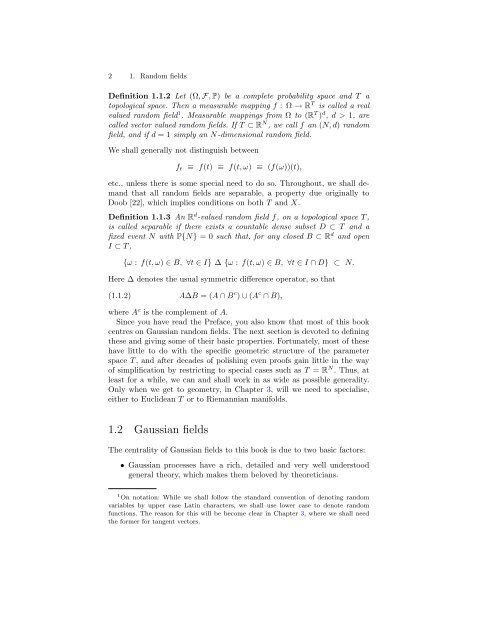You also want an ePaper? Increase the reach of your titles
YUMPU automatically turns print PDFs into web optimized ePapers that Google loves.
2 1. Random fields<br />
Definition 1.1.2 Let (Ω, F, P) be a complete probability space and T a<br />
topological space. Then a measurable mapping f : Ω → R T is called a real<br />
valued random field 1 . Measurable mappings from Ω to (R T ) d , d > 1, are<br />
called vector valued random fields. If T ⊂ R N , we call f an (N, d) random<br />
field, and if d = 1 simply an N-dimensional random field.<br />
We shall generally not distinguish between<br />
ft ≡ f(t) ≡ f(t, ω) ≡ (f(ω))(t),<br />
etc., unless there is some special need to do so. Throughout, we shall demand<br />
that all random fields are separable, a property due originally to<br />
Doob [22], which implies conditions on both T and X.<br />
Definition 1.1.3 An R d -valued random field f, on a topological space T ,<br />
is called separable if there exists a countable dense subset D ⊂ T and a<br />
fixed event N with P{N} = 0 such that, for any closed B ⊂ R d and open<br />
I ⊂ T ,<br />
{ω : f(t, ω) ∈ B, ∀t ∈ I} ∆ {ω : f(t, ω) ∈ B, ∀t ∈ I ∩ D} ⊂ N.<br />
Here ∆ denotes the usual symmetric difference operator, so that<br />
(1.1.2)<br />
A∆B = (A ∩ B c ) ∪ (A c ∩ B),<br />
where A c is the complement of A.<br />
Since you have read the Preface, you also know that most of this book<br />
centres on Gaussian random fields. The next section is devoted to defining<br />
these and giving some of their basic properties. Fortunately, most of these<br />
have little to do with the specific geometric structure of the parameter<br />
space T , and after decades of polishing even proofs gain little in the way<br />
of simplification by restricting to special cases such as T = R N . Thus, at<br />
least for a while, we can and shall work in as wide as possible generality.<br />
Only when we get to geometry, in Chapter 3, will we need to specialise,<br />
either to Euclidean T or to Riemannian manifolds.<br />
1.2 Gaussian fields<br />
The centrality of Gaussian fields to this book is due to two basic factors:<br />
• Gaussian processes have a rich, detailed and very well understood<br />
general theory, which makes them beloved by theoreticians.<br />
1 On notation: While we shall follow the standard convention of denoting random<br />
variables by upper case Latin characters, we shall use lower case to denote random<br />
functions. The reason for this will be become clear in Chapter 3, where we shall need<br />
the former for tangent vectors.
















